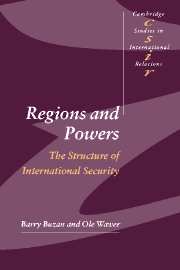Book contents
- Frontmatter
- Contents
- List of illustrations
- Preface
- List of abbreviations
- 1 Patterns of regional security during the Cold War
- 2 Patterns of regional security post-Cold War
- Part I Introduction: developing a regional approach to global security
- Part II Asia
- Introduction
- 4 South Asia: inching towards internal and external transformation
- 5 Northeast and Southeast Asian RSCs during the Cold War
- 6 The 1990s and beyond: an emergent East Asian complex
- Conclusions: scenarios for the Asian supercomplex
- Part III The Middle East and Africa
- Part IV The Americas
- Part V The Europes
- Part VI Conclusions
- Glossary
- References
- News media
- Index of names
- General Index
- CAMBRIDGE STUDIES IN INTERNATIONAL RELATIONS
Conclusions: scenarios for the Asian supercomplex
Published online by Cambridge University Press: 05 December 2009
- Frontmatter
- Contents
- List of illustrations
- Preface
- List of abbreviations
- 1 Patterns of regional security during the Cold War
- 2 Patterns of regional security post-Cold War
- Part I Introduction: developing a regional approach to global security
- Part II Asia
- Introduction
- 4 South Asia: inching towards internal and external transformation
- 5 Northeast and Southeast Asian RSCs during the Cold War
- 6 The 1990s and beyond: an emergent East Asian complex
- Conclusions: scenarios for the Asian supercomplex
- Part III The Middle East and Africa
- Part IV The Americas
- Part V The Europes
- Part VI Conclusions
- Glossary
- References
- News media
- Index of names
- General Index
- CAMBRIDGE STUDIES IN INTERNATIONAL RELATIONS
Summary
Which SCT scenarios are possible and which are not in Asia? Given the level of development of the region, the unstructured scenario is ruled out for all parts of it. Overlay is also ruled out other than existing US commitments in Japan and South Korea. No outside state, not even the USA, now has the capacity to overlay the region, and no state within the region has the capacity to establish suzerainty over it. China would be the only possible candidate for that role and, whatever traditional inclinations to seek regional suzerainty might still live within its political instincts, it lacks both the coercive capability and the civilisational attractiveness that it once possessed. As Van Ness (2002: 143) notes, China has no real soft power resources, and its communist government is now mostly a liability in terms of international image and attractiveness. Like Europe before it, Asia now has too many substantial powers within it to allow any one of them to take over the whole, and it has collectively become too big a centre of power for any one country to dominate it without that domination having major repercussions at the global level. Asia's future is thus as some form of RSC, which leads to questions about its shape, and about its essential structure in terms of polarity and amity–enmity.
Asia has already seen one internal transformation (Southeast Asia) and one external one (the merger of the Northeast and Southeast Asian complexes).
- Type
- Chapter
- Information
- Regions and PowersThe Structure of International Security, pp. 172 - 182Publisher: Cambridge University PressPrint publication year: 2003



